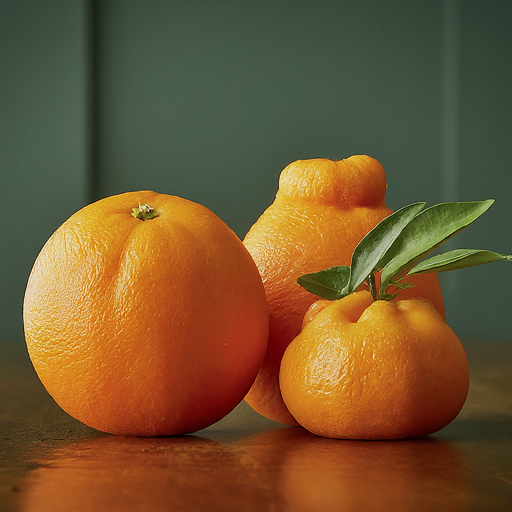
Exploring the Citrus Delights: Minneola and Tangelo Oranges
Share
Exploring the Citrus Delights: Minneola and Tangelo Oranges
In the vast world of citrus fruits, oranges hold a special place in our hearts and diets, celebrated for their vibrant color, refreshing taste, and numerous health benefits. Among the wide variety of oranges, Minneola and Tangelo stand out for their unique flavors, textures, and nutritional profiles. This blog post delves into the fascinating world of Minneola and Tangelo oranges, exploring their characteristics, health benefits, culinary uses, and tips for selection and storage.
Minneola Oranges
Characteristics
Minneola oranges, often referred to as Minneola tangelos, are a hybrid fruit, a cross between Duncan grapefruit and Dancy tangerine. This gives them a distinctive bell shape, with a slightly elongated neck at the stem end. They are known for their deep orange, smooth, and easy-to-peel skin. The flesh inside is juicy, vibrant, and seedless or contains a minimal number of seeds, making them a convenient and delightful snack.
Flavor Profile
The flavor of Minneola oranges is a perfect balance between the tartness of its grapefruit parent and the sweetness of the tangerine. This combination results in a tangy, slightly sweet taste with a bold citrus aroma that is more intense than that of many other orange varieties.
Nutritional Benefits
Minneola oranges are a powerhouse of nutrients. They are rich in vitamin C, providing well over the daily recommended intake in just one serving. This boosts the immune system and aids in the absorption of iron from plant-based foods. They also contain good amounts of dietary fiber, which promotes digestive health, and are a source of vitamins A and B, potassium, folate, and magnesium.
Tangelo Oranges
Characteristics
Tangelo oranges, like Minneolas, are a hybrid, but they come from a broader mix of tangerine and grapefruit varieties. They share the bell-shaped appearance and easy-to-peel feature with Minneolas, though they can vary more in size and seed content. Tangelos are known for their juicy texture and slightly thick skin.
Flavor Profile
Tangelos offer a unique taste that is immediately recognizable for its sweet yet tart flavor, leaning more towards the tangerine side of its ancestry. They have a juicy, refreshing quality that makes them incredibly satisfying to eat fresh out of hand.
Nutritional Benefits
Tangelos share many of the same nutritional benefits as Minneola oranges, being an excellent source of vitamin C and fiber. They also contribute to your daily intake of calcium, vitamin B6, and antioxidants, which help fight free radicals and support overall health.
Culinary Uses
Both Minneola and Tangelo oranges are versatile in the kitchen. They can be used in salads, desserts, and marinades, or simply juiced for a refreshing drink. Their bold flavors make them ideal for enhancing the taste of cakes, marmalades, and even savory dishes like roasted meats or seafood.
Selection and Storage
When selecting Minneola or Tangelo oranges, look for fruits that are firm, heavy for their size (indicating juiciness), and have a bright, unblemished skin. Avoid any fruits with soft spots or signs of mold. These oranges can be stored at room temperature for a few days but will last longer when refrigerated, extending their freshness for up to two weeks.
Conclusion
Minneola and Tangelo oranges are not just delicious fruits; they are nutrient-rich, versatile ingredients that can brighten up your meals and boost your health. Whether enjoyed fresh, squeezed into a juice, or incorporated into your cooking, these citrus delights offer a delightful mix of flavors and benefits that make them worth seeking out. Next time you're at the grocery store, don't hesitate to add Minneola and Tangelo oranges to your cart and experience their exceptional taste and nutritional advantages.